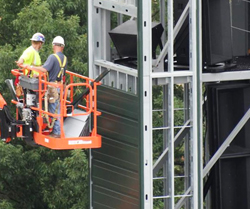
“Firing 500 to 600 feet to the south end zone seating was the most complicated and difficult throw,” says Palavos. “It’s a balancing act to get that right and to still get even coverage and SPL at mid-field, beneath the clusters and the upper deck.”
The loudspeaker set affixed to the northeast scoreboard is a mirror image of that affixed to the northwest scoreboard.
On each, a pair of stacked Jericho J3s handle the far throw, whereas a single J3 handles the intermediate throw for the near- and medium-sideline stands.
Three vertically-stacked TH 812 subwoofers per side collapse the low-frequency beam to provide throw.
The TH 812, nicknamed the “Rock Monster,” incorporates eight 12-inch long-excursion woofers, also horn-loaded.
Ten smaller Danley SH 46 loudspeakers supply fill for areas on the north side of the stadium that are in the “shadows” of the larger boxes, such as very near the scoreboards and under the near balconies.
Getting It There
The system’s digitally networked front end is straightforward. A Yamaha LS9 digital console provides user control of input source selection and volume. It’s output feeds a pair of Peavey MediaMatrix NION processors with Audinate Dante networking cards, which in turn feed HP ProCurve network switches over fiber.

At each scoreboard, Lab.gruppen FP 7000 and FP 9000 Series power amplifiers drive the TH 812 subs (with crossovers provided by MediaMatrix NION) and the SH 46 fill loudspeakers. However, signal is routed to a Danley DSLP 48 digital processor before traveling to the J3 Jericho Horns.
“In the processor, Danley has optimized the crossovers and processing necessary to get the very best performance from the J3,” Palavos explains. “You can’t really recreate that in another manufacturer’s processor.”
All rack equipment is housed in secure, environmentally-controlled conditions, which includes both air-conditioning and heating. “Michigan starts its season humid and hot and ends it cold and snowy,” observes Palavos. An analog backup over fiber allows the system to operate even if the digital backbone and network go down.

Nice Surprises
System tuning proved a bit less challenging that usual because, as Palavos notes, the specifications of the Danley products match their actual performance, and in his view, they “sound good out of the box.”
“In such a complex environment, having a well-designed and engineered product is essential,” says Palavos. “Danley does a good job of engineering up front, which means there is less time required at commissioning to get the system optimized.
“One of the surprises to the MSU staff after the new system was implemented was that the quality of their source material needed to be improved. With the previous system, they couldn’t hear what was lacking.”
Preliminary measurement data acquired at the stadium indicates that the system measures a consistent +/- 3 dB at most of the nearly 80,000 seats, a testament both to the components and skilled implementation by a team of veteran professionals.
